The uterine fibromatosis is the most frequent benign tumoral pathology of the female genital tract, is produced by the action of estrogen on the smooth uterine muscle forming fibro muscular tumors called fibroids, fibromas or leiomyomas. Localization variable and multiple location, they can completely alter the normal architecture of the uterus.
Myomectomy is the resection of leiomyomas uterine preserving the uterus to re-establish its architecture in order to permit pregnancies, limit pain and menstrual bleeding.
Depending on the size, number, location, and experience of the surgeon could decide practice (minilaparotomy) limited open surgery or laparoscopy (you are having long boom at present, indeed it is expected to be the procedure of choice).
In cases of infertility, resection of submucosal and intramural fibroids would have a positive effect on the possibility of obtaining a pregnancy.
After having practiced a myomectomy pregnancy is resolved through a caesarean section because there is risk of uterine rupture after week 30 of pregnancy and especially during labor.
Our surgical team specializes in the removal of fibroids giant preserving healthy uterus and doing everything to maintain or improve soil fertility without exposing the life of the patient by bleeding or collateral injury. These cases are operated on by open surgery and we try to keep the aesthetic effect in the surgical wound.
Handling non-surgical or minimally invasive of the fibroids
- The decline in female hormones own menopause favors atrophy of the fibroids. If you are menopausal or close to it without any symptom the fibroids disappear alone.
- Low-dose oral contraceptives or progestogen exclusive (minipill) pills control partially or totally bleeding symptoms in a considerable number of patients, even decrease could be of the size of the fibroids but it is not consistent.
- The intrauterine device MIRENA has been proven effective in bleeding control of uterine fibromatosis and partially reduce the size of the present fibroids. Do not delete them but it could keep them controlled during the 5 years of use of the device; the results are very variable.
- The use of analogues of GnRH (Leuprolide, e.g.) is moderately effective in the reduction of the size of the fibroids through the creation of a reversible menopausal status. Do not delete them, smaller (30-40%) makes them during the effect of the drug, 3 to 6 months, but the menopausal symptomatology can be a problem. Osteoporosis is another risk.
- Selective embolization is a method performed by radiologists experts through which you reach the artery that irrigates the fibroma and occludes with special means (microspheres). Eliminate them but the cost is high and can affect the uterus healthy if not done correctly. There is a reported case of an amputation of a leg by erroneous embolization of the iliac vessels.
Traditional open surgery, laparotomy
We use the transverse incision low, aesthetic and quick loss. We favor a technique of extracorporeal to decrease bleeding and the manipulation of the pelvic organs for better recovery and less postoperative pain. We enucleamos each myoma trying to use a single uterine incision to preserve the integrity of the body
Advantages:
- A single wound about 7-10 cm not visible under the underwear or swimwear. That same scar will be used for the future that will in the event of pregnancy c-section since the uterine surgery contraindicated a vaginal birth. It allows resection of multiple fibroids and fibroid greater than 7 cm or giant cases.
- Minimum operating time, 30 minutes or less.
- Low uterine collateral damage from handling.
- Lower cost.
Disadvantages:
- Greater surgical pain and adhesion formation.
- Larger wound.
Laparoscopy
Using the via laparoscopic are placed 3-4 ports for the instrumental videoendoscopico and surgical. Fibroids is independent and is individually dissected each of them
Advantages:
- Three or four small wounds in three or four parts of the abdomen, visible, that together they reach approximately 3 cm.
- Minor bleeding and formation of postoperative adhesions in the pelvis.
- Less postoperative pain and rapid recovery.
- Laparoscopy makes the surgeon, by principle, more careful, skillful and with a much more fine knowledge of the female anatomy: decreases risk complications and collateral damage.
Disadvantages:
- High cost or at least greater than traditional surgery.
- If you want to remove the entire piece must be a wound the size required low (which eliminates one of the reasons for the laparoscopy), otherwise special equipment is required to break up the fibroids within the abdomen (Morcelador, increases the cost surgical).
- Surgical time much larger and more complicated procedure (this is remedied with the skill of the surgeon). Touch is very important to detect small and deep lesions may be drawn if the lesion is not visible.
- It requires training/skill in intra or extracorporeal suture.
- In case of pregnancy, it will require a c-section and hence abdominal surgery low in the future. It does not save the future abdominal scar.
Conclusions
Due to the technique that we've perfected the way opened on the laparoscopic we prefer since it is cheaper, faster, less bleeding, with comparable recovery and best uterine repair.
Types of myomectomy
Open Myomectomy: mini laparotomy
Open resection of a giant fibroid of 15 cm with more than 1000 grams weight. This case was not likely to be solved by laparoscopy since the procedure, even when possible, was the closure that would take much time to be realized and this went against the interests of the patient and of the principles of segur surgical suppport.
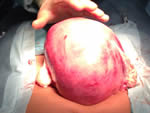
Another severe case, the uterus is somewhere under the fibroids.
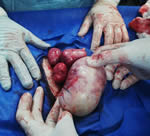
In the following composition you can see another severe case with successful results, the bleeding was minimal but still required blood transfusion: removed part a large volume of blood is removed next to it; the patient should be operated with low levels of hemoglobin by intractable anemia. We avoid the use of blood products but they are indicated when strictly necessary.
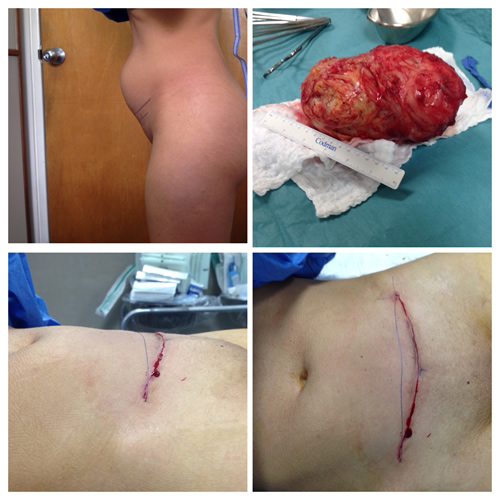
Note: in unusual cases where the lesion is not so big the skin incision is half of the practiced in this case.
Laparoscopic Myomectomy:
A fibroid resection following criteria for laparoscopic surgery: less than 7 cm fibroid, number less than 3 fibroids, less than 2 previous pelvic surgery, surgical equipment and experience skill in intracorporeal suture
This picture shows the opening of the outer muscles of the uterus to expose the surface of the fibroid that serve foryour further purchases.
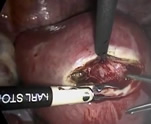
Surgery of the Dr Wattiez promoter of the Winners Project for global training of Surgeons with high standards of training gynecological. IRCAD France.
The Winners Project is a scheme ambitious blended learning training based on the web through the IRCAD and WebSurg French training newspapers and difficulty progressive to prepare suitable and homogeneously efficient surgery professionals Laparoscopic and minimally invasive of the woman (in the area that is me).
Miomatomas and cancer?
A myoma sarcomatous degeneration (malignant) is extremely rare and so is the primary uterine sarcoma. Thus, any structure aspect fibroid to grow quickly or does not have the typical traditional fibroid ultrasound image makes us suspect and practiced surgery in the short term. A case in 1000, so there is no worry much about this rare possibility. I discuss this so that you do not go running to operate you for fear of a cancer alone because you have a few small fibroids!
Problem and meaning: a very variable condition
This graph shows the varied locations of fibroids and their tendency to great variability of sizes. There is usually a few but they can be to have severe cases as this, although it is not common to find them. This takes too long and the modern ultrasonic diagnosis is made early.
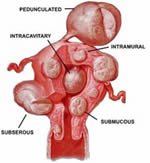
In most cases the fibroids does not generate any symptom, even in advanced cases. They do surgical when they give frequent symptoms by bleeding, chronic pelvic pain, or other abdominal viscera compression.
These cases, our unity presents unique, giant, fibroids removed in its entirety. Reason for surgery: primary infertility, menstrual bleeding, and chronic pelvic pain.
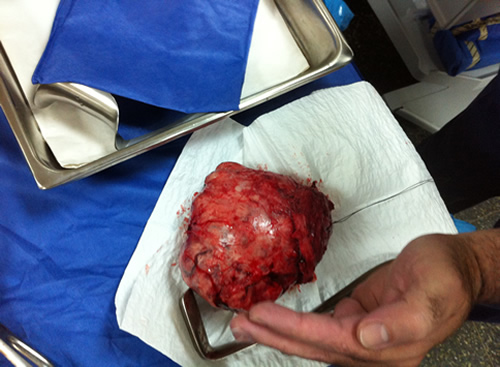
In the operating room, during the extraction, despite the size of the lesion it is clear that bleeding is minimal.
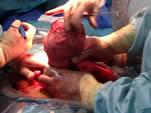
Fibroids with its typical appearance of swirling Pearly fibers in round shape, well circumscribed and encapsulated, thus ensuring their criteria of benign tumor can be seen in one-piece anatomical cut surgical (uterus).

Is this condition serious? My life present or future danger?
This is a benign condition of low overall risk that does not endanger your life immediately. Genital bleeding even when abundant are not intense enough to bleed you in a short time. The patient was anemiza in weeks or months so that there is much time to adopt measures that could improve the clinical condition of the patient if decided that surgery is indicated. This is not considered an emergency in the strict use of the word.
When there is compression of surrounding organs, especially of the urinary tract, it should intervene in the shortest time possible to avoid irreversible damage to the function of the affected organs, but this is quite rare.
Infertility
Fertility is could be affected because of the location and the number of injuries. Fibroids that most affect fertility are those located in the endometrial cavity (Submucosos) since they affect the delicate architecture that promotes implantation of the embryo. It is possible that the intraluminal partially affect the fertility. The surface or mouth do not have any effect.